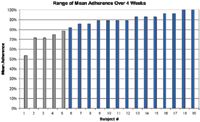- General Dermatology
- Eczema
- Chronic Hand Eczema
- Alopecia
- Aesthetics
- Vitiligo
- COVID-19
- Actinic Keratosis
- Precision Medicine and Biologics
- Rare Disease
- Wound Care
- Rosacea
- Psoriasis
- Psoriatic Arthritis
- Atopic Dermatitis
- Melasma
- NP and PA
- Skin Cancer
- Hidradenitis Suppurativa
- Drug Watch
- Pigmentary Disorders
- Acne
- Pediatric Dermatology
- Practice Management
- Prurigo Nodularis
Article
AKs in seniors: Study participants demonstrate high rate of compliance with 5-fluorouracil
In a recent study, seniors showed an unexpectedly high rate of compliance with 0.5 percent five-fluorouracil treatment for actinic keratoses, the study's lead author says.

Key Points

"No one has studied compliance in the elderly population when it comes to topical medication, so we wanted to study topical medication adherence in this patient population, and its relation to clinical outcomes," says Brad Yentzer, M.D., senior clinical research fellow, dermatology, Wake Forest University Baptist Medical Center, Winston-Salem, N.C.

For the study, investigators enrolled 20 subjects who were at least 50 years old and had moderate-to-severe AKs on the face and anterior scalp.
Researchers instructed them to apply 0.5 percent 5-FU (Carac, Sanofi-Aventis) once daily for four weeks. Unbeknownst to patients, researchers monitored adherence via electronic Medication Event Monitor Systems (MEMS, Aardex Ltd.) hidden in the caps of the medication tubes.
To measure efficacy, investigators calculated the decrease in patients' lesion counts from baseline. They took assessments at baseline and at follow-up visits on weeks two, four and eight, with the last visit occurring four weeks after treatment had concluded.
All but one subject completed the study.
Adherence
On an individual basis, adherence to daily application of 5-FU ranged from 54 percent to 100 percent.
"Of our 19 subjects, 14 (74 percent) were adherent to treatment, which we defined as having an individual mean adherence rate of 80 percent throughout the trial," Dr. Yentzer tells Dermatology Times.
Adherence rates for the five patients who didn't meet this cutoff ranged between 52 percent and approximately 79 percent.
Mean adherence to the prescribed medication regimen, moreover, remained high throughout the study. Mean adherence among all patients was 92 percent during the first week and fell only to 82 percent by study's end, he says.
Efficacy
Similarly, Dr. Yentzer says the medication's overall efficacy was excellent.
Over the course of the study, the mean number of facial AKs fell from 9.1 to 2.2, while the mean number of scalp lesions fell from 5.6 to 0.9.
The treatment achieved a median clearance of 80 percent of all lesions, with the greatest improvement occurring after the active treatment period at week eight.
Paradoxically, investigators noted an increase in the number of AKs during the first few weeks of treatment. This suggests that 5-FU may cause subclinical AKs to become detectable, Dr. Yentzer says.
"Perhaps there were AKs there already that we weren't seeing," he says, "and maybe the inflammation from the medication made them more visible."
Study investigators don't know exactly why the number of AKs initially increased, but researchers have reported this phenomenon in other studies involving Carac and Aldara (imiquimod, Graceway), Dr. Yentzer says.
The bottom line is that clearing the entire affected AK field could help reduce recurrence rates (Krawtchenko N et al. Br J Dermatol. 2007 Dec;157 Suppl 2:34-40; Jorizzo J et al. Arch Dermatol. 2004 Jul;140(7):813-6), he says.
Patients tolerated the treatment well. They reported no serious adverse events, and no subject discontinued treatment due to adverse events. Nevertheless, 79 percent of patients reported at least one side effect such as tenderness, burning, blistering or redness.
Surprised by results
Patients' overall compliance rate surprised researchers, Dr. Yentzer says.
"When patients are putting on something irritating," he says, "one would expect people to maybe apply it once or twice, get irritated and stop using it. Or they might take a holiday, as it were, decreasing the dosing to every other day or every third day to try to decrease the side effects."
However, he says, "It may just be that older folks are more adherent to treatment for one reason or another." If they're retired, perhaps they have more time available than younger patients, and seniors often are accustomed to taking other medications for conditions that aren't skin-related, he says.
"There's also the fact that we were treating AKs, which are premalignant by nature," Dr. Yentzer says.
Elderly patients are likely to be aware of this link, and perhaps study patients adhered faithfully to the medication regimen because they feared developing cancer, he says.
At the same time, he says 5-FU's irritating nature actually may have boosted compliance, because patients perceived it was working.
Disclosure: Sanofi-Aventis funded this study. However, Dr. Yentzer reports no personal financial interests with this company or any other.
For more information: http://www.aad.org/ http://www.wfubmc.edu/





